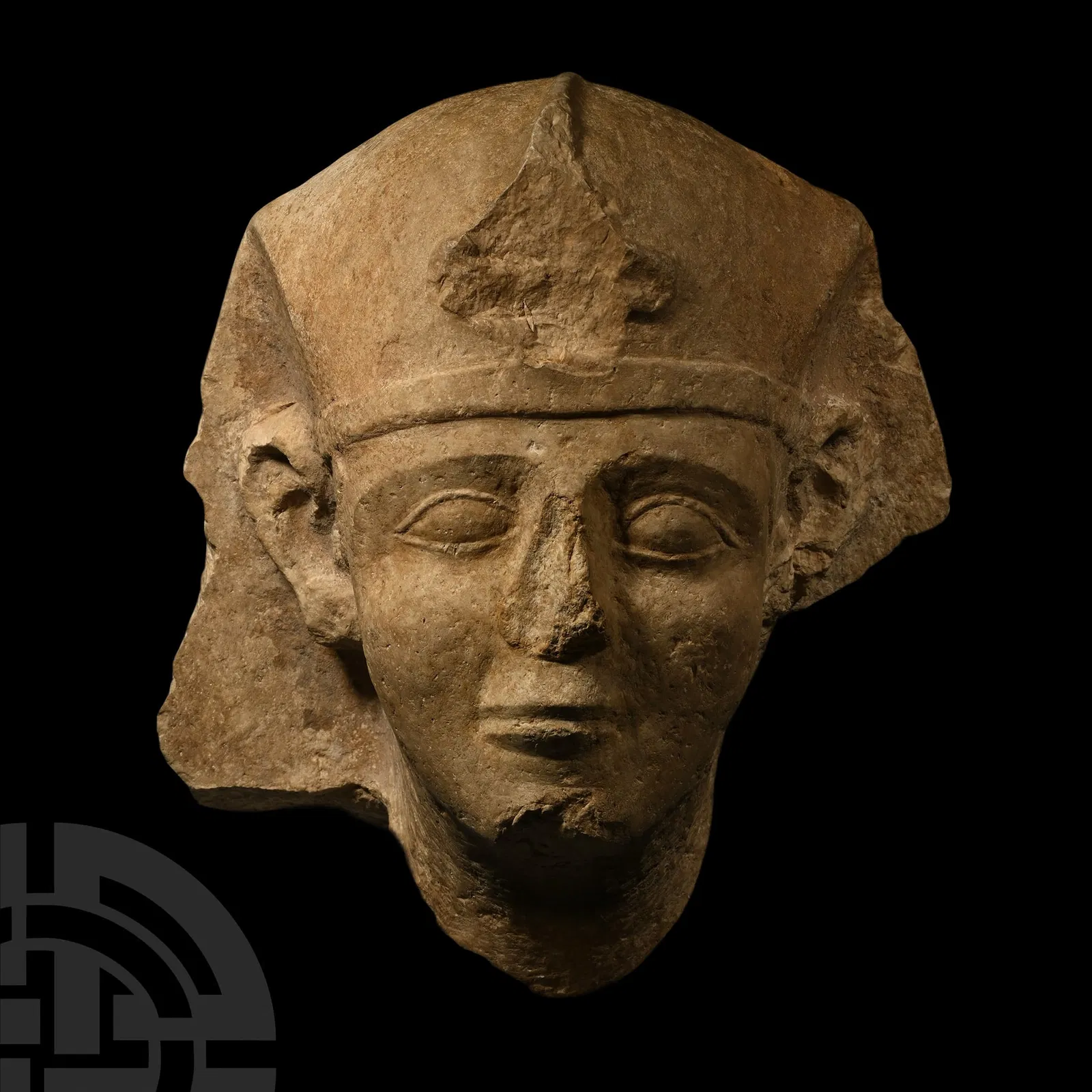TimeLine’s March 4-9 Antiquities Auction takes collectors on a fascinating journey through the past with rarely-seen ancient art and artifacts
Featured: Massive Levantine-Egyptian stone head of pharaoh, other rare marbles, 1st century AD jeweled cameo of Augustus, 6th-7th century AD Sasanian silver-gilt jar with dancing girls, ancient armor, coins

ESSEX, UK – Britain’s TimeLine Auctions, venerable auctioneers and specialist dealers of antiquities since 1858, will host a wide-ranging and fully-vetted six-day sale of ancient art, books, natural history rarities and coins starting Tuesday, March 4 and concluding on Sunday, March 9. All lots featured in the lavishly illustrated hardcover catalogue are from the March 4 live gallery session. Auction entries from all six days may be viewed online or in the company’s printed PDF catalogues, which include authoritative descriptions and multiple photographic views of each item. Also, in the case of premier lots offered on Day 1, bidders are sure to enjoy the scholarly video commentaries presented by chartered auctioneer and renowned antiques expert Tim Wonnacott. All forms of remote bidding will be available throughout the sale, including live online through TimeLine’s website.
Rare and exceptional artworks and relics from the world’s most acclaimed cultures will cross the auction block along with antiquities from even earlier societies that influenced human progress. The latter would certainly include the civilizations of South Arabia, which presciently cultivated agricultural products and spices. Their cultures were also based around the use of incense, as exemplified by an impressive auction highlight: a figural incense burner from the 7th-6th century BC.
The bronze, bowl-form piece is surmounted by spikes and flanked by two large aviform supporters, each having one long curving wing to the vessel’s exterior. The obverse is decorated with a raised legend in South Arabian script intersected by a rampant quadruped, possibly a lion. The burner reputedly came from the temple of “Athtar dhu-Garb in al-Sawda” (ancient Nashshan) in the Jawf of Yemen. It was previously held in the private collection of Shlomo Moussaieff (1925-2015), Israel; passed by family descent, then was acquired privately in 2021. Similar to pieces in the Metropolitan Museum of Art and The British Museum, it is estimated at £15,000-£20,000 ($18,650-$24,860).
One can only marvel at the breathtaking artistry seen in a monumental Levantine-Egyptian stone head of a pharaoh from the Ptolemaic Period, 332-30 BC. This massive sculpture likely came from an enormous sphinx. It wears a royal nemes headdress with a prominent headband and the remains of rearing uraeus on the brow, and its facial features include large almond-shape eyes and slightly pursed lips. At 17 inches (43cm) high, it comes mounted on a custom-made display stand. Prior ownership includes consecutive European private collections (from 1975), subsequent private acquisition and family descent. Accompanied by an academic report prepared by Egyptologist Paul Whelan, this fabulous treasure carries a £40,000-£60,000 ($49,720-$74,580) estimate.
Another wonderful Egyptian artwork is a limestone low-relief frieze of a fishing scene from the Saite Period, 664-525 BC. It displays a beautifully carved depiction of hips and legs of two standing figures with their day’s “catch,” a long-finned fish. Measuring 9 inches high and mounted on an old stand, its line of provenance includes a European private collection and a 1991 sale at Sotheby’s London. It could reel in a winning bid of £12,000-£17,000 ($14,920-$21,130).
Dating to circa 1500-1300 BC, an Indo-Gagetic copper anthropomorphic idol from India consists of a large, flat-section figure with curled arms, spread legs and a lobed head, mounted on custom-made stand. Exhibiting a high standard of artistry, this important piece measures 14¼ inches (36.3cm) wide. Works of its type and age are discussed in The Bronze Age Metalwork of India, Prahistorische Bronzefunde X (P Yule, 1985). Its ownership can be traced back to a 1950s English private collection, followed by Atigh Gallery (pre-1986), and with Aaron Gallery, which acquired the antiquity from the previous source. Accompanied by a copy of a 1986 invoice from Atigh Gallery, it is expected to achieve a winning auction bid in the vicinity of £18,000-£24,000 ($22,380-$29,830).
For those who admire the distinctive beauty of Greek Attic pottery, Timeline is pleased to suggest a circa 520 BC black-figure lekythos of ovoid shape with a slender neck, trumpet-shape mouth, strap handle and discoid foot. It is adorned with a well-composed combat scene involving three Hoplites, the first in a tall-crested Corinthian helmet, who thrusts his long spear toward the shielded middle figure whose own spear is blocked by a third figure. This 10 3/8in (26.5cm) vase, of a type that would have stored oil, ointments or perfume, is similar to an example in The Metropolitan Museum of Art in New York. Its provenance can be traced to a German private collection of the 1960s, followed by a 2013 auction in Germany where it was acquired by its present owner. Estimate: £20,000-£30,000 ($24,860-$37,290)
A very fine Scythian Chalcidian or Illyrian variant (Caucasian type) helmet from the 3rd-1st century BC is handsomely embossed with images of stags on both sides and ram horns on its brow. It was constructed from two joined halves, with hinged cheek-pieces. Its background includes acquisition on the European art market in the mid-1980s, subsequent ownership by an Oxford, UK private collector; and most recently a London doctor. Comparable to examples in several important reference books and publications, it will convey with an academic report prepared by Dr Raffaele D’Amato. Estimate: £18,000-£24,000 ($22,380-$29,830)
Three exceptional Roman antiquities highlight the sale, the first being an agate cameo of Augustus from the 1st century AD. The profile portrait bust is presented in an antique gold pendant frame with surrounding emerald, sapphire and ruby cabochons; and clusters of pearls. It is marked on verso 750 in a rectangle Bd G, which is believed to represent an upstate New York jeweler’s stamp; along with an indeterminate third mark. Its total weight is 99 grams, and its illustrious line of provenance includes an early-20th-century New York collection, the Robert Haber Gallery, New York, in 1990; and the collection of Jean Clostre of Geneva, Switzerland. Thus museum-quality piece is accompanied by a scholarly report from Dr. Ittai Gradel, who notes that the cameo is “of exquisite technical quality” and has “a close parallel in the Cabinet des Medailles, Paris.” Estimate: £30,000-£40,000 ($37,290-$49,720)
A superb circa 1 AD Roman (Augustan) Parian marble portrait of Gaius Julius Caesar Vipsanianus (20 BC-4 AD) was modeled in the round and carved with soft facial features, a long neck, and hair trimmed in Julian style. With a height of 19 inches (48cm) inclusive of its custom-made stand, the marble compares to examples in several important books and publications about Roman historical portraits. Acquired on the London art market in the 1970s, followed by a 2007 appearance at Christie’s and 2015 sale at Bonhams (both in London), with consecutive private owners in between, this lot will convey with an academic report from Raffaele D’Amato. Estimate: £18,000-£24,000 ($22,380-$29,830)
A second noteworthy Roman marble is a 2nd century AD head of a barbarian. Carved in the round, it depicts a Dacian or Germanic warrior with high cheekbones, a narrow chin, small pointed beard and broad, curved moustache. The center-parted hair is cut moderately short with fringe, and the almond-shape eyes are deep-set with heavy lids. Having a height of 8 3/8in (21.5cm) inclusive of its custom-made stand, the marble claims prestigious provenance: Marlaud de Serres, France, acquired in the 1980s; a 2011 sale at Christie’s Paris; and a Swiss private collection. Also, it was exhibited at Harwich Museum, Harwich, Essex, UK, in 2025. A photo of artefacts in that display is included with the auction lot, as is an academic report by Dr Raffaele D’Amato, copies of the sculpture’s French cultural passport, and other important documentation. Estimate: £12,000-£17,000 ($14,920-$21,130)
A sensational 6th-7th century AD Sasanian silver-gilt jar serves as a testament to how long dancing has existed as a form of human expression. It is adorned with repousse figures of three nude dancing girls with draped swags of cloth, as well as images of a peacock and two small boys around the vessel’s circumference. Standing 7 3/8 inches (18.7cm) high, it comes with several reports, including an academic one from Dr Raffaele D’Amato. Similar to examples in several important reference books and museum collections, this rare and extraordinarily fine work of art has graced a private collection since the 1960s and is now guided by an auction estimate of £15,000-£20,000 ($18,650-$24,860).
TimeLine’s March 4-9, 2025 auction will be held live at the company’s head office located at The Court House, 363 Main Rd., Harwich, Essex CO12 4DN, UK. All lots featured in TimeLine’s hardcover catalogue will be auctioned during the March 4 opening session. Internet bidders may pre-register online. Goods may be previewed in person at the gallery by prior arrangement only. Auction start time: 7am US Eastern time/12pm (midday) GMT. All remote forms of bidding will be available, including absentee, by phone (please book phone line 48 hours ahead of time), or live via the Internet through TimeLine’s bidding platform or LiveAuctioneers. TimeLine Auctions accepts payments in GBP and ships worldwide. Questions: call +44 7494 866514 or email Aaron Hammond at [email protected]. Website: https://timelineauctions.com.









